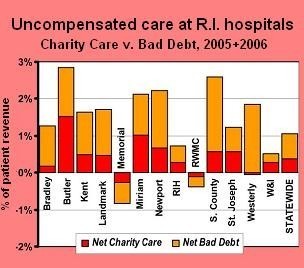
PROVIDENCE – Uncompensated care at hospitals statewide increased by 5.69 percent from 2005 to 2006, but its share as a percentage of total patient revenue “did not change appreciably,” the R.I. Department of Health’s Center for Health Data & Analysis said today.
But the Hospital Association of Rhode Island condemned the state report, saying it “grossly understates the uncompensated care provided by hospitals to Rhode Island’s neediest residents.”
Net uncompensated care at the state’s 13 hospitals – calculated based on the subsidies each institution received to compensate for charity care and bad debt – rose to $26.0 million in 2006, an increase of $1.4 million from the year before, the department said. That imposed an average burden equivalent to 1.05 percent of net patient revenue, down from 1.06 percent in 2005.
Two hospitals had negative burdens for uncompensated care – Memorial Hospital of Rhode Island in Pawtucket (-0.72 percent) and Roger Williams Medical Center in Providence (-0.22 percent) – as they received offsetting revenue in excess of actual bad-debt and charity care provided. The burdens at the other 11 hospitals ranged from a low of 0.60 percent at Women & Infants Hospital of Rhode Island in Providence to a high of 3.17 percent at South County Hospital in South Kingstown, the state report said.
Kent, Newport, South County, Westerly and Women & Infants all saw their uncompensated care burdens rise in 2006, while Bradley, Butler, Landmark Medical Center, The Miriam and St. Joseph saw their burdens decline.
When 2005 and 2006 figures were combined, to minimize volatility in the statistics, Butler, South County and Newport Hospitals had the largest burdens for uncompensated care (as a percentage of net patient revenue), the study found, and the burdens were smallest at Memorial and Roger Williams Medical Center, where offsetting revenue exceeded uncompensated care in both years, and Women & Infants.
For charity care alone, wrote study author Bruce Cryan, “Bradley and Butler present interesting contrasts in that Bradley had the fourth lowest net charity care burden (0.19%), while Butler had the highest burden (1.53%). This may be partially explained by their patient populations, irrespective of the fact that both hospitals are behavioral health providers.
“Bradley serves children and adolescents, with the indigent portion of this population covered by the state’s comprehensive RIte Care program.
“Butler, on the other hand, serves mostly adults (with some adolescents). For the indigent of that adult population, there is no comprehensive payor of last resort,” Cryan noted.
“Hospitals are an important part of the health care safety net, and provide a large amount of uncompensated care as a benefit to the community,” said Ana Novais, executive director of the Health Department’s Division of Community Health & Equity. “This report provides Rhode Islanders with a more comprehensive picture of the actual expenses of uncompensated care to hospitals, after acknowledging the subsidies they receive to compensate for these un-reimbursed services.”
This year, for the first time, the study also examined the settings in which charity care is provided and bad debt incurred. In contrast to the usual belief that emergency rooms account for the bulk of charity care, it found that nearly 50 percent of such care was provided to hospital inpatients, 30 percent in outpatient settings and only 20 percent in the emergency department. The results on bad debt were less surprising: More than 60 percent was incurred by uninsured patients and only 20 percent by patients covered by commercial health insurance.
But in a statement this evening, HARI President Edward J. Quinlan described the state’s data and methodology as “significantly flawed.”
“Using data provided to the R.I. Department of Health by hospitals, HARI has calculated uncompensated care to total $124.9 million in 2006, an increase of 16 percent from 2005,” he said. “This is a noteworthy difference from the information reported by the department.
“We are concerned this report may generate confusion about this important issue. As the State of Rhode Island and the R.I. General Assembly continue to address difficult budget and policy issues, this report does a disservice to policymakers,” Quinlan said. “We urge the Department to rescind this report.”
For additional news and information from the R.I. Department of Health, including the full 2006 Hospital Net Uncompensated Care Report, visit www.health.ri.gov.










